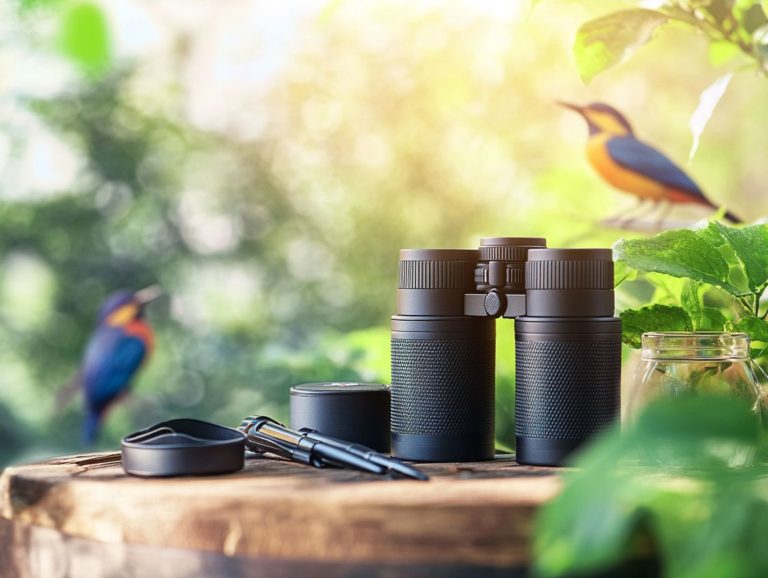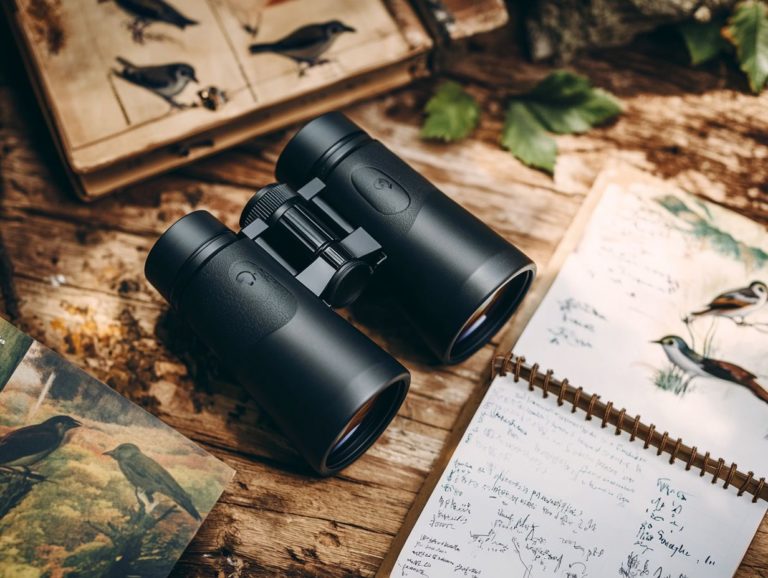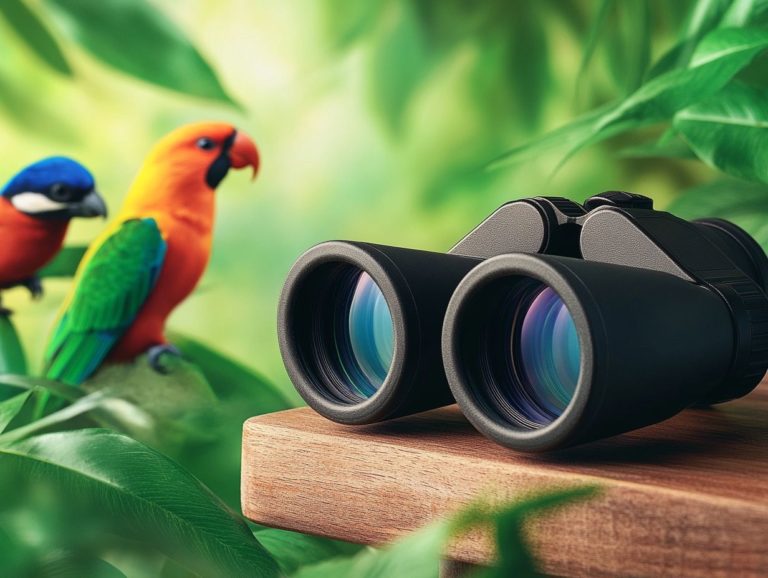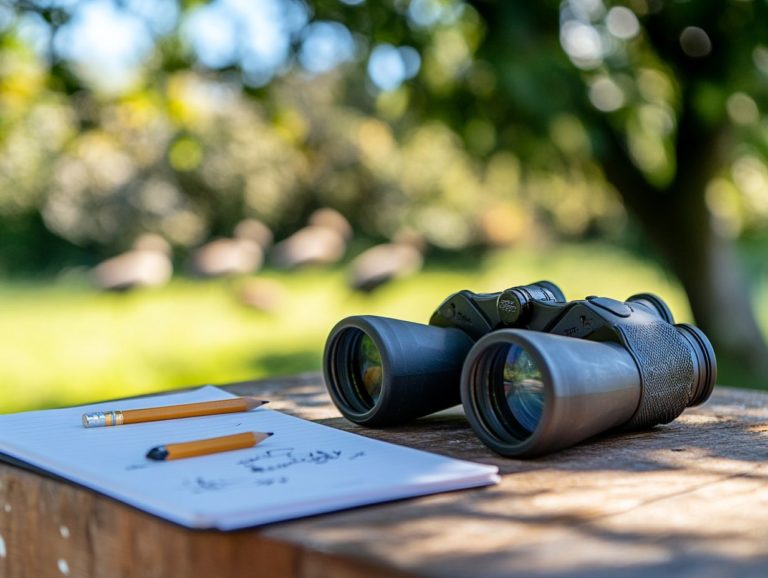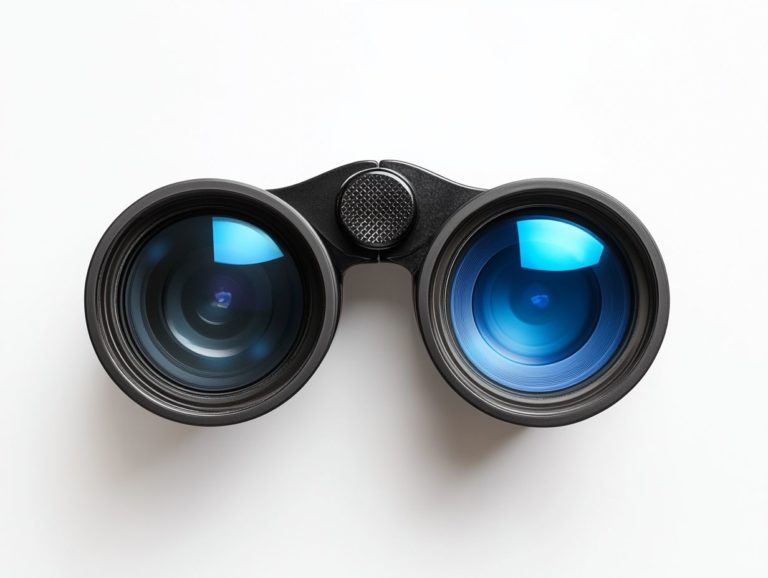Understanding Field of View in Birding Binoculars
Birding binoculars are indispensable tools for birdwatchers. Not all binoculars offer the same quality.
One key aspect to keep in mind is the field of view, which can significantly influence your birdwatching experience.
This article delves into what field of view entails, why it holds such importance, and how to select the ideal one for your specific needs.
By exploring the distinctions between wide-angle and narrow-angle views, along with tips for optimizing binocular performance, you ll uncover valuable insights to elevate your birding adventures.
Contents
- Key Takeaways:
- Field of View Explained
- How to Choose the Right Field of View
- Types of Field of View
- Advantages and Disadvantages of Different Field of View
- Improving Field of View in Birding Binoculars
- Frequently Asked Questions
- What is Field of View in Birding Binoculars?
- Why is Field of View Important for Birding?
- How Does Magnification Affect Field of View in Birding Binoculars?
- What is a Good Field of View for Birding Binoculars?
- Can the Field of View be Adjusted on Birding Binoculars?
- Are there any other factors to consider besides field of view when choosing birding binoculars?
Key Takeaways:

- Field of view is a crucial factor to consider when choosing birding binoculars, as it determines the area you can see at a given distance.
- Wide angle FOV provides a broader view, making it easier to locate and follow birds, while narrow angle FOV offers greater detail and is ideal for stationary observation.
- To improve FOV in birding binoculars, use proper positioning and techniques such as scanning and tracking to make the most of your binoculars’ capabilities.
What are Birding Binoculars?
Birding binoculars are your ticket to an enhanced birding experience, expertly crafted to give you a crystal-clear view of distant feathered friends. You ll find a range of configurations, like the popular 8×42 and 10×42 models, all boasting premium optics that excel in light gathering and image clarity.
Whether you prefer porro prism or roof prism designs, you can choose the perfect pair that aligns with your specific needs and preferences. This ensures comfort and ease during those extended observation sessions.
Your choice of binoculars can dramatically influence your overall birdwatching adventure. Top-notch brands like B&H Photo offer an impressive array of options that cater to both novices and seasoned birders alike.
When you re on the hunt for binoculars, pay close attention to factors such as magnification power, lens size, and field of view. Higher magnification lets you see greater detail, while models with wider fields of view help you keep up with those swift, elusive birds.
Don t overlook features like waterproofing and ergonomic designs; they are essential for durability and comfort, making binoculars an invaluable tool in your birdwatching arsenal.
Field of View Explained
The field of view (FOV) is a pivotal feature of binoculars that dictates how much of the scene unfolds before you at any given moment. For birders, understanding the field of view in spotting scopes becomes an essential consideration.
A wider FOV facilitates the effortless tracking of moving birds, enriching your overall birding experience, while a narrower field may hone in on specific details.
Grasping the nuances of FOV is crucial when you re choosing binoculars, as it directly influences usability across diverse birdwatching scenarios, especially in fluctuating light conditions.
Definition and Importance
The field of view (FOV) is your window into the observable world, measured in feet at 1,000 yards when using binoculars. The field of view is your secret weapon for spotting birds! A wide FOV makes tracking birds in flight much easier, greatly enhancing your overall birding experience.
By grasping the concept of FOV, you can choose the perfect binoculars tailored to your viewing conditions whether you re navigating dense forests or scanning open fields.
For example, while binoculars with high magnification offer detailed glimpses of distant birds, they often come with a narrower field of view. This limited perspective can turn spotting and following fast-moving birds into a challenging endeavor.
On the flip side, binoculars with lower magnification typically present a wider FOV, providing a broader view that s ideal for keeping up with flocks or spotting elusive species in flight.
Binoculars that excel in light-gathering capabilities can significantly improve visibility in dim lighting conditions, such as during the early morning or late evening when many bird species are most active. By understanding the intricacies of FOV, you ll be equipped to maximize both your enjoyment and success in the field.
How to Choose the Right Field of View
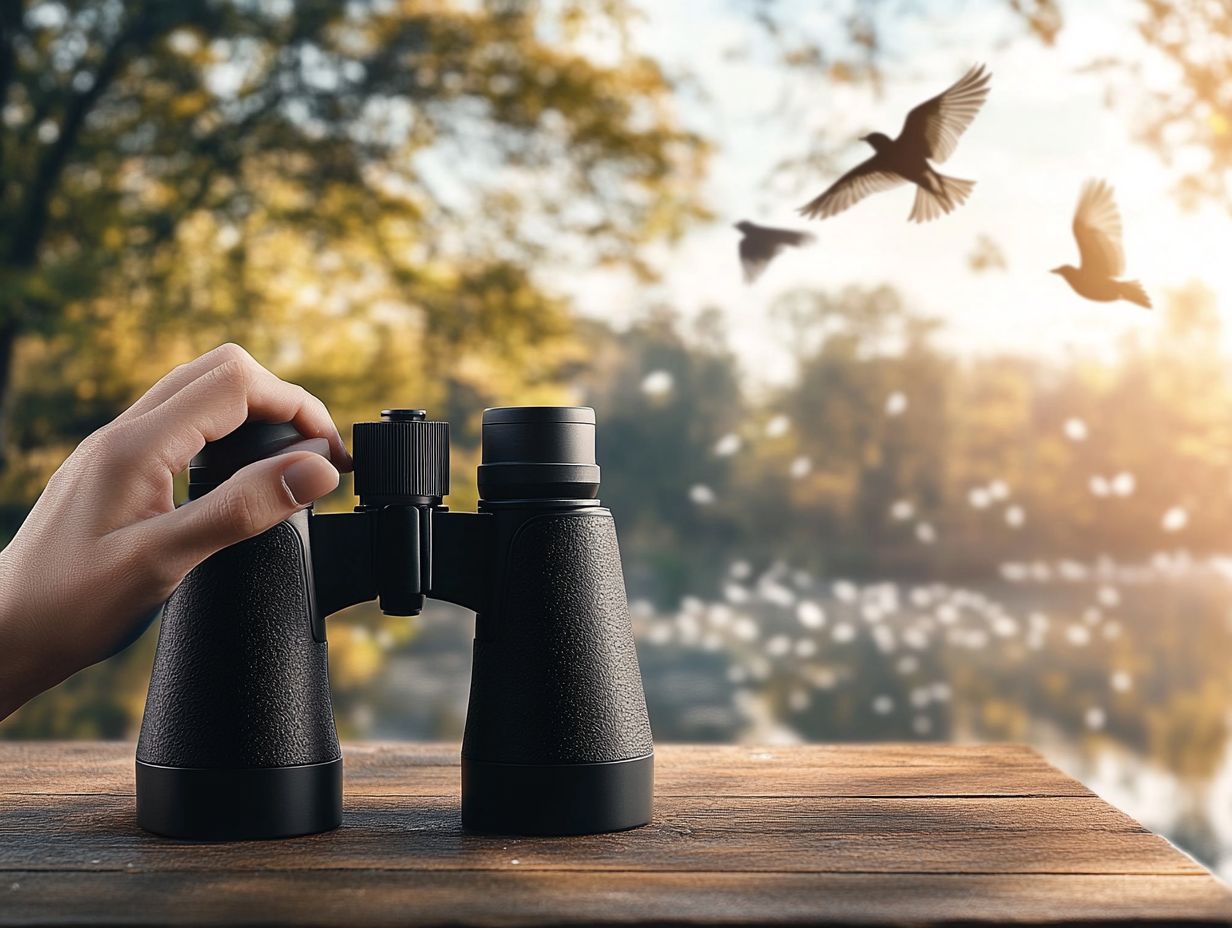
Choosing the right field of view can transform your birding adventures! Selecting the ideal field of view for your binoculars is crucial for enhancing your birding experience. To learn more about this, check out the importance of binoculars in birding, as several factors need your attention to make an informed choice.
The best FOV is influenced by where you like to birdwatch and your personal preferences concerning binocular configurations, whether it s 8×42, 10×42, or more portable options.
Understanding your birdwatching needs alongside various specifications available in different models helps you choose binoculars that strike a harmonious balance between FOV and essential features like magnification and ergonomics.
Factors to Consider
When selecting binoculars, consider several critical factors that significantly influence your choice regarding field of view. Magnification, light quality, and overall comfort are pivotal elements in this decision-making process.
Magnification means how much closer things appear, so finding a balance is essential. Higher magnification often leads to a narrower field of view, which might not align with your birding needs.
Ergonomics and light-gathering abilities matter too, as these can elevate your viewing experience in various lighting conditions. A lightweight design enhances handling and reduces fatigue during long observation sessions, making your experience much more enjoyable.
Don t overlook the ocular lens and prism types. High-quality optics deliver brighter images and improved depth perception key for tracking moving subjects. Adjustments like eye relief are especially important if you wear glasses, as they can significantly influence your comfort and satisfaction with the binoculars.
By considering these factors, you ensure that your chosen instrument becomes an extension of your own vision.
Types of Field of View
The various types of field of view, including wide angle and narrow angle, are essential in determining the effectiveness of binoculars for birding enthusiasts like you.
A wide-angle field of view presents a broader perspective, making it easier for you to spot and track fast-moving birds. In contrast, a narrow angle offers a more concentrated view, allowing for detailed observations at greater distances.
Understanding these differences will help you choose binoculars tailored to your personal preferences and specific usage scenarios.
Wide Angle vs. Narrow Angle
Wide angle and narrow angle fields of view play a big role in how binoculars perform for birdwatching. Wide angle binoculars give you a larger view, making it easier to track birds as they move around.
If you enjoy watching birds in wetlands or open fields, wide angle binoculars can help you spot them quickly. They let you adjust your focus fast, so you won t miss anything exciting!
On the other hand, if you prefer to watch birds that stay still, like perched raptors, narrow angle binoculars are a great choice. They provide clearer details, making it easy to admire a bird s beautiful feathers from far away.
Think about the birding experience you want, and you can select the binoculars that will enhance your enjoyment and effectiveness in the field.
Advantages and Disadvantages of Different Field of View
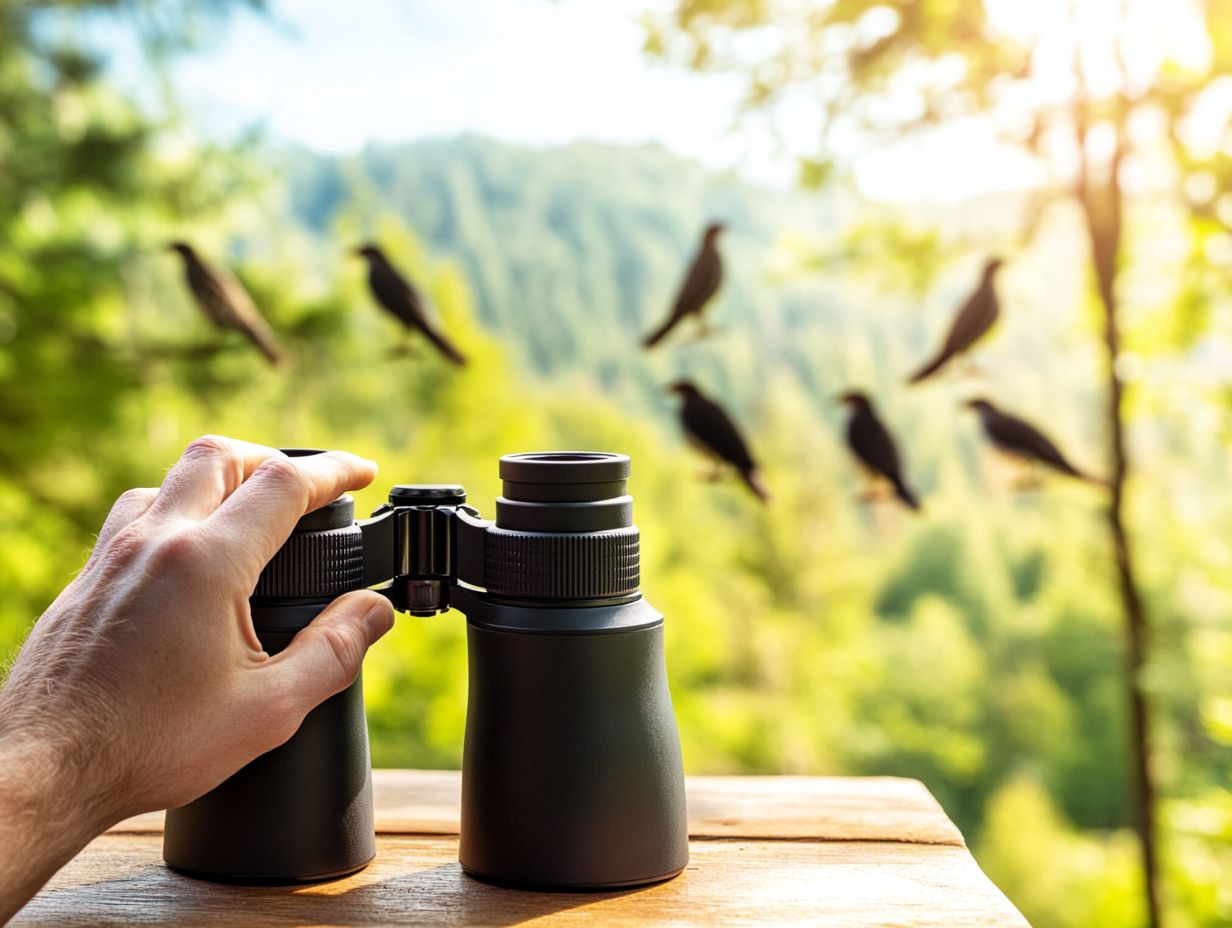
Evaluating the advantages and disadvantages of various fields of view is crucial for birders aiming to elevate their birding experience. Wide-angle binoculars offer the benefit of a broader perspective, making it easier to track birds in flight. However, they may compromise the level of detail that narrow-angle models provide, which excel at observing distant subjects.
By understanding these trade-offs, you can confidently choose binoculars that perfectly match your individual viewing preferences and the specific conditions of your birding adventures.
Pros and Cons of Wide Angle and Narrow Angle
The pros and cons of wide-angle and narrow-angle fields of view are vital considerations for you as a birder seeking the ultimate binocular experience. Choose the right type of binoculars to elevate your outdoor adventures.
For instance, wide-angle binoculars, often boasting fields of view exceeding 7 degrees, enable you to capture a broader swath of your surroundings. This feature makes it easier to spot elusive species darting through the trees.
Conversely, narrow-angle binoculars focus their view, often delivering a clearer, more detailed image of distant birds. This can be especially beneficial in expansive landscapes like wetlands, where your subjects are often quite far away.
Whether you prioritize tracking fast-moving flocks or observing solitary birds resting on distant branches, your choice between these two types can dramatically influence both your enjoyment and success during birdwatching outings.
Improving Field of View in Birding Binoculars
Enhancing the field of view in birding binoculars will truly enhance your birding experience. There are several strategies worth considering to optimize this feature. For example, understanding what to look for when buying birding binoculars can help you make informed decisions.
Make key adjustments, such as choosing the right magnification and grasping the nuances of binocular coatings, to achieve a broader field of view. By applying these strategies, you can ensure more effective tracking and observation of your avian companions.
Effective Tips for Better Viewing
To enhance the field of view in your binoculars, you can employ a variety of tips and techniques, from making the right adjustments to embracing proper maintenance practices. Regularly cleaning the lenses and ensuring they are aligned can significantly elevate light quality and overall performance, ultimately improving your field of view.
- Inspect the components of your binoculars, such as the eyepieces and objective lenses, for dirt or smudges that might cloud your clarity.
- Use a microfiber cloth and a lens cleaning solution specifically designed for optics to make a world of difference.
- Adjust the interpupillary distance (the distance between your pupils) for comfort and optimal vision, ensuring that the image remains crisp across the entire field.
Over time, keep an eye out for any misalignments or mechanical issues; even minor adjustments can dramatically enhance your viewing experience in the field. By combining these practices with a bit of patience, you ll unlock the full potential of your binocular set, especially when tracking those elusive bird species.
Frequently Asked Questions
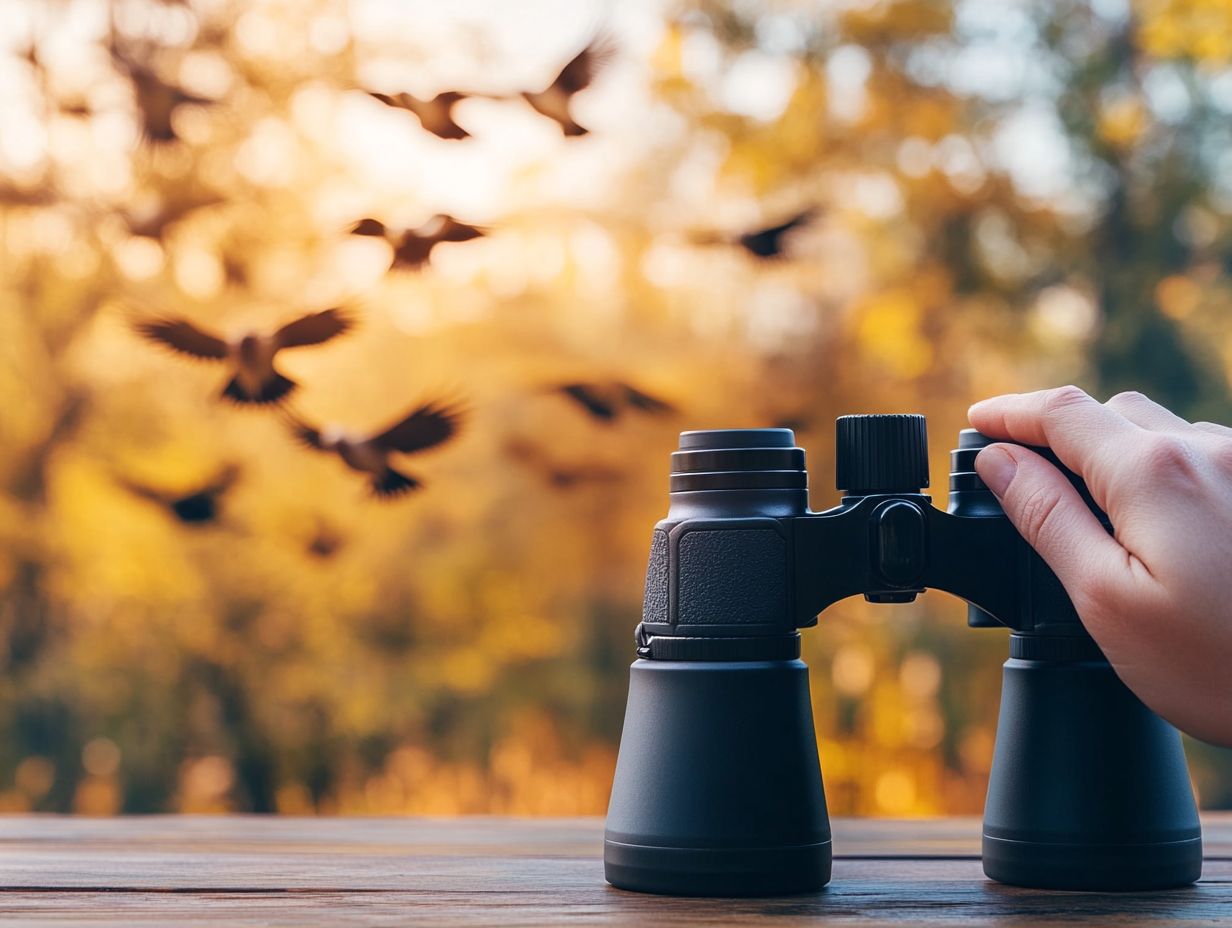
Get out there and discover the wonders of birdwatching with your newly optimized binoculars!
What is Field of View in Birding Binoculars?
Field of view is the width of the area visible through binoculars. It s measured in feet or degrees and varies with magnification and design.
Another essential feature to consider is close focus, which allows you to see objects up close.
Why is Field of View Important for Birding?
Field of view is crucial for birding because it determines how much area you can observe at once.
A wider field of view helps you spot and follow birds more easily. You can use platforms like eBird to track bird activity effectively.
How Does Magnification Affect Field of View in Birding Binoculars?
Higher magnification narrows the field of view. It makes images larger but reduces the visible area.
Choosing the right binocular settings is key to finding the best balance.
What is a Good Field of View for Birding Binoculars?
A field of view of at least 300 feet at 1000 yards is ideal for birding. This allows you to notice birds and follow their movements without constant adjustments.
Many birders prefer binoculars like 7×42 for their great combination of magnification and field of view.
Can the Field of View be Adjusted on Birding Binoculars?
No, the field of view is a fixed feature and cannot be adjusted. It depends on the binoculars’ design and magnification.
Understanding binocular comfort and ergonomics can greatly enhance your birdwatching experience.
Are there any other factors to consider besides field of view when choosing birding binoculars?
Yes, you should also think about magnification (how much closer objects appear), lens quality, and weight. Trying out different binoculars will help you find the perfect fit for your needs.
Retailers like B&H Photo offer a variety of options to explore.


